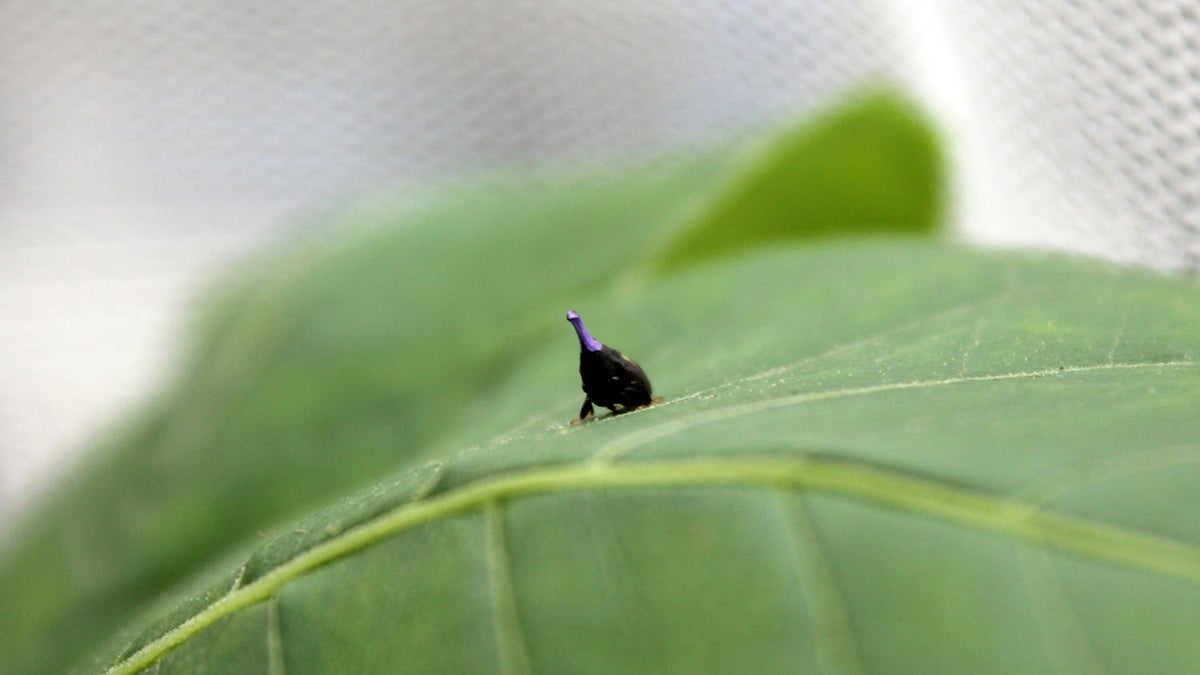Good vibrations! These bugs do their sexting via plant stem
Listen
This treehopper in a greenhouse at Saint Louis University would not normally have a purple horn or "pronotum." It was painted that color for identification purposes. (Veronique LaCapra/St. Louis Public Radio)
On a warm summer night, it can sound like there are insects all over the place, calling out from every lawn, bush and tree branch. But most of what insects are saying to one another we can’t hear.
Saint Louis University evolutionary ecologist Kasey Fowler-Finn has been listening in on the hidden world of insect communication and one bug’s unusual love songs.
That bug is called a treehopper. They’re actually pretty common — but easy to miss. The ones that Fowler-Finn studies in Missouri and Illinois are known by the Latin name of Enchenopa binotata. They’re small and black — the “binotata” in their name means “two marks,” referring to the two yellow spots on their backs. When you see them clinging to a plant stem, they look a lot like tiny thorns.
Fowler-Finn wants to understand the behavior of treehoppers. Specifically, she wants to know how they go about finding mates.
“Males fly from stem to stem or plant to plant, and when they land, they create advertisement signals,” Fowler-Finn said. “Then, if the female likes that male, she’ll call back.”
Fowler-Finn thinks these treehoppers sound a lot like little whales.
“I love them,” Fowler-Finn said. “They’re super cute, they’re full of personality, and are just a lot of fun to listen to.”
That is, if you can hear them. The problem with treehoppers — for scientists like Fowler-Finn, who study them — is that these little bugs don’t make sounds the way we do. The sound waves from our voices travel through the air. Some big insects — like cicadas, crickets, and katydids — also make airborne sounds.
But to be heard through the air, you have to be loud, and that takes a lot of energy — too much for tiny insects like treehoppers. So they send their calls vibrating through a plant stem.
“The plant stem actually physically moves,” Fowler-Finn said. “Not enough that we can see it, but enough that they can pick it up with really sensitive sensors in their legs.”
For insects, communicating through a substrate — like a plant stem, or leaf litter — isn’t as unusual as you might think.
“It’s actually quite common,” Fowler-Finn said. “About 90 percent of insects communicate through substrate-borne vibrations.”
With tens of millions of insect species out there, that’s a lot of chatter — almost none of which we can hear with the naked ear.
But, given a little help, we can tune right in. To listen to treehoppers in her lab, Fowler-Finn uses a laser. The treehoppers sit on a plant called a wafer ash inside an incubator in front of the laser beam. Reflective tape on the plant bounces the laser light back into a sensor.
“The laser then, it’s measuring the velocity of the vibration of the plant stem,” Fowler-Finn said. “And the velocity directly translates into the pitch, or the frequency, of the signal.”
A signal — or sound — that we can hear, and that Fowler-Finn can capture and record on a laptop.
Females of this particular kind of treehopper usually go for males that call at a frequency of 385 hertz (cycles per second). But in the lab, Fowler-Finn can play them calls of lots of different frequencies. To the females, it sounds like they have lots of males to choose from, and the more choices they think they have, the pickier they get about answering back.
“You don’t want to be super picky if you only have crappy males around,” Fowler-Finn said. “But then if you know that you do have choice, it might benefit you to be pickier and to wait for that male that you really like.”
Fowler-Finn is currently working with one of her graduate students to figure out how temperature affects treehopper-calling behavior. They expect to have their first results by next spring.
WHYY is your source for fact-based, in-depth journalism and information. As a nonprofit organization, we rely on financial support from readers like you. Please give today.



